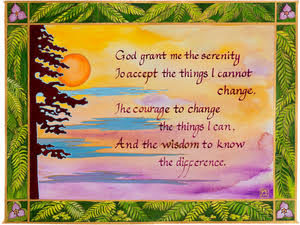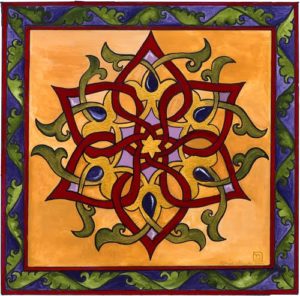Today, SevenPonds speaks with Rabbi Me’irah, a San Francisco-based rabbi and visual artist. After earning a master’s degree in social work from Portland State University, Rabbi Me’irah spent 15 years in the field. Along the way, she reconnected with her spirituality and enrolled in rabbinical college with the goal of becoming ordained. She became one of the first graduates of the Gamliel Institute, an organization that teaches Jewish end-of-life care traditions (called Hevra Kadisha). She teaches at Jewish community and assisted living centers, as well as from her personal rabbinate, Verses Illuminated.
 Marissa: Are there certain Jewish funeral traditions that you find especially helpful for families and loved ones? And what makes them so helpful?
Marissa: Are there certain Jewish funeral traditions that you find especially helpful for families and loved ones? And what makes them so helpful?
Rabbi Me’irah: There are. I do many funerals, and I try to include as many funeral traditions as I can. We try to accomplish the funeral as soon after the death as possible so that the family knows where the body is and that it is taken care of. During a Jewish funeral, we encourage people to give a hesped, or eulogy. Writing this helps the mourner sort out their feelings. And it is also a mitzvah, a way of honoring the deceased.
We walk in a procession from the chapel to the place of burial, usually chanting. As we walk, we pause seven times to show our reluctance to take this last journey. We sing the 23rd Psalm and what I think is the most beautiful prayer in Judaism, the prayer for the departed. This prayer asks God to shelter the soul under wings of protection; to bind up the soul in the bundle of life “in the highest heavens amongst the most holy and pure, where the brilliance of the heavens radiate;” and to let the soul rest in peace.
At a Jewish funeral, we also encourage the mourners to place shovels full of earth gently on the casket. Hearing the first thud of earth, placed by the rabbi, is a potent marker of the reality of death. We leave the cemetery after rinsing our hands with water to mark the separation of death from life. Then the family goes home, or to another comfortable place, to begin shiva. They stay at home and attend to their grief, while the community brings them food and prays with them. Traditionally, this is done for seven days, with prayer services conducted both morning and evening. At each gathering, the family and community are invited to share memories of the deceased.
Marissa: Tell me more about shiva.
Rabbi Me’irah: We have some interesting customs during shiva. One is that you bring food for the family, especially food that is round in shape, to remind us of the cycle of life. You do not speak to the mourner unless the mourner speaks to you first, so as not to burden them with having to respond to you. You don’t chit-chat with the other guests. The door is left ajar, and the guests simply walk in so that the mourner doesn’t need to act like a host or hostess. In our more liberal strands of Judaism, we have lost the knowledge of many of these things. But an atmosphere of community support and dignity still prevails.

One of Rabbi Me’irah’s verse paintings.
Marissa: Many people fear death. How do you coach people through this fear?
Rabbi Me’irah: You know, honestly, many of the people I have been with near death have been on medication. Some have had dementia, and most people really near death are “in another world.” If I speak to someone further from that imminent time, I try to understand what they are fearing. Pain? Punishment? Dying with unresolved issues? Concern for those left behind? There are many intricacies to fear. So first, I try to discern what it is they are fearing in particular.
Marissa: How have you helped families cope with loss over the years?
Rabbi Me’irah: One story comes to mind. I had been visiting with a severely demented person while I was doing hospice work. She was in a memory care center, and she sat on her lounge chair, head turned toward her fidgeting fingers in her lap, humming to herself most of the day. She had been a member of a congregation, so she was familiar with common prayer songs. Sometimes her daughter would come and visit when I was there. The daughter visited out of duty and to honor her deceased father. Her father loved this wife, even though the daughter was not especially fond of her.

Rabbi Me’irah’s painting of the Star of David. She says that this is an excellent meditation piece for people to reflect on life.
She called me one day to let me know that her mother’s disease had progressed to the point where she was dying. She was now in a separate room, lying down, pretty much unresponsive. I met the daughter and we went in together. We talked softly. Then we began to sing a song about the four archangels surrounding and protecting her mother. In a remarkable split second of clarity, the mother opened her eyes and looked at her daughter and smiled. Then she closed them again and returned to her former position. We were both so struck, that had we not had the other there to confirm what had happened, we might not have believed it. The daughter was thrilled that she “communicated” this one bit with her mother.
The woman died later that afternoon. The daughter was convinced that our singing together had helped relieve any fear her mother had and allowed her to die. I went on to do the funeral for the family, and the daughter told me that the way her mother was able to die had brought her peace. This is an example of how “a good death” can ease the mourning period.
Marissa: You mention prayer songs. Are there any sacred verses that capture the meaning of life and death for you?
Rabbi Me’irah: I feel that this is practically the aim of all religion: to answer, “What are we here for?” When one is satisfied with what one has done with their life, then I think death is not fearful (as long as pain is removed from the equation, which we are 99 percent able to do in this period of history). I have been thinking about making a book of songs to sing for the dying: an ornamented beautiful ritual object. We have so many prayers that, when put into the context of death, suddenly have new meaning. Here are the words to one we sing on Friday evening to welcome the Sabbath:
As the deer yearns for the brooks of cool water
So does my soul yearn for you, Ahhhh Holy One
My soul thirsts for you, the Living God.
Marissa: That’s beautiful! Thank you so much for sharing your knowledge of Jewish funeral traditions with our readers.
Rabbi Me’irah: You’re welcome.
If you missed part one of our interview with Rabbi Me’irah, you can read it here.

 Which Jewish Funeral Traditions Help People Overcome a Fear of Death?
Which Jewish Funeral Traditions Help People Overcome a Fear of Death?


 Debating Medical Aid in Dying
Debating Medical Aid in Dying
 “Help Me, Helen”
“Help Me, Helen”















